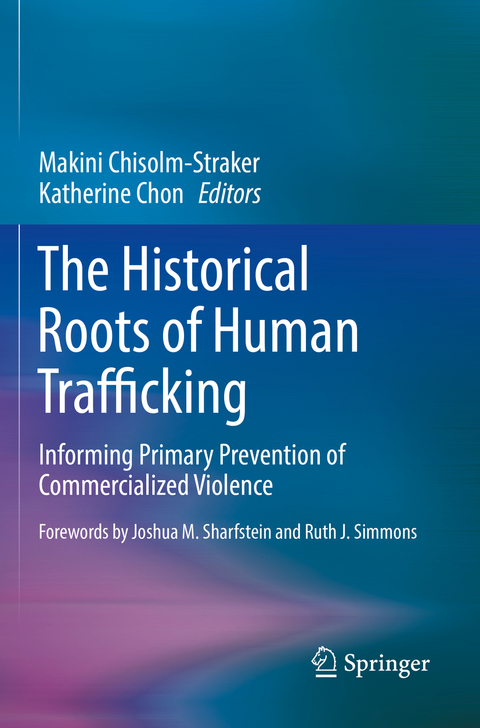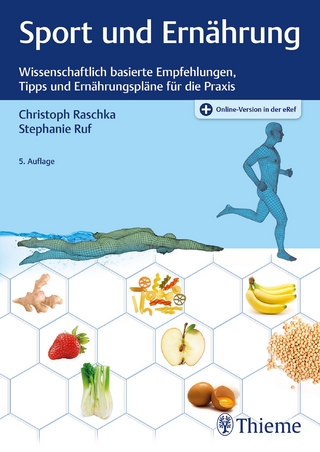
The Historical Roots of Human Trafficking
Springer International Publishing (Verlag)
978-3-030-70677-7 (ISBN)
- Capitalism, Colonialism, and Imperialism: Roots for Present-Day Trafficking
- Invisibility, Forced Labor, and Domestic Work
- Addressing Modern Slavery in Global Supply Chains: The Role of Businesses
- Immigration, Precarity, and Human Trafficking: Histories and Legacies of Asian American Racial Exclusion in the United States
- Systemic and Structural Roots of Child Sex Trafficking: The Role of Gender, Race, and Sexual Orientation in Disproportionate Victimization
- The Complexities of Complex Trauma: An Historical and Contemporary Review of Healing in the Aftermath of Commercialized Violence
- Historical Context Matters: Health Research, Health Care, and Bodies of Color in the United States
The Historical Roots of Human Trafficking is essential reading for students of public health, health sciences, criminology, and social sciences; public health professionals; academics; anti-trafficking advocates, policy-makers, taskforces, funders, and organizations; legislators; and governmental agencies and administrators.
lt;b>Makini Chisolm-Straker, MD, MPH has served in the anti-trafficking field for over 15 years. She conducts original public health research about human trafficking; for example, Dr. Chisolm-Straker collaborated with Covenant House New Jersey to develop the first validated, labor and sex trafficking screening tool (for use among young adults experiencing homelessness). Dr. Chisolm-Straker educates clinicians on how to serve this patient population and advises and collaborates with policymakers on ethical, inclusive, person-centered anti-trafficking prevention and intervention efforts. She served on the S.O.A.R. initiative of the U.S. Department of Health and Human Services to develop a comprehensive, introductory educational program for healthcare practitioners serving patients with trafficking experience. Dr. Chisolm-Straker is interested in how primary prevention rooted in history and understanding of systems and intersectionality of experiences lead to effective anti-trafficking action. Dr. Chisolm-Straker earned her Medical Doctorate and Bachelor of Arts in Religious Studies from Brown University in Providence, Rhode Island, and her Master of Public Health with a Certificate in Public Health and Humanitarian Aid from Columbia University in New York City.
Katherine Chon, MPA is a Bloomberg American Health Initiative Fellow at the Johns Hopkins School of Public Health, in Baltimore, Maryland, focused on violence prevention based on eighteen years of experience developing organizations and shaping strategies to combat human trafficking. Ms. Chon is the founding director of the Office on Trafficking in Persons at the US Department of Health and Human Services (HHS), strengthening the Nation's public health response to human trafficking through data-driven policies, programs, and primary prevention. She is the federal executive officer of the National Advisory Committee on the Sex Trafficking of Children and Youth in the United States and serves on numerous federal interagency working groups including the Senior Policy Operating Group of the President's Interagency Task Force to Monitor and Combat Trafficking in Persons. Prior to government service, Ms. Chon was the co-founder and president of Polaris, establishing the global organization's innovative programs to assist survivors of trafficking, expand anti-trafficking policies, and fundamentally change the way local communities respond to human trafficking. Ms. Chon is an advisor to Brown University's Center for the Study of Slavery and Justice and a member of the National Academies of Sciences, Engineering, and Medicine's Committee on Approaches to Estimating the Prevalence of Human Trafficking in the United States. She received her Master in Public Administration from Harvard University Kennedy School of Government in Cambridge, Massachusetts, and Bachelor of Science in Psychology from Brown University in Providence, Rhode Island. Any views expressed within this textbook are solely those of the respective authors and editors and do not necessarily represent the views of HHS or the United States.
lt;b>FOREWORDS: Georges Benjamin with public health perspective; Ruth Simmons with historical perspective
PREFACE (Katherine Chon, Makini Chisolm-Straker): Describe why historical understanding of the impacts of debt bondage, slavery, indentured servitude, and trafficking are important to present-day public health's anti-trafficking efforts. Explicitly situate this textbook as a historical reference for root cause, primary prevention anti-trafficking work in contemporary USA. (3-5 pages)
SECTION I: MARKET DYNAMICS OF HUMAN TRAFFICKING (EXAMPLE INDUSTRIES)1. Editor's Introduction - Katherine Chon, Makini Chisolm-Straker: Provide a brief overview of legal and illicit markets (historical and present) impacted by human trafficking (include reference to the Polaris typology report, US Government reports on goods and products made by forced labor and worst forms of child labor, federal investigations into major labor trafficking cases). Describe how industries infiltrate the fabric of all American lives, and how a successful public health approach requires multiple governmental agencies (e.g., HUD, DOE, DOA) engaged in exploitation and development prevention work. (2-3 pages)
2. Capitalism, Colonialism, and Imperialism: Roots for Present-Day Trafficking - William Tucker, Flavio Casoy, Sofia Rower: Provide basic historical foundation for trafficking understanding, as woven into the economic fabric of the USA. Author team speaks to roots of nationalism, racist ideology, sexism, classism, and religionism (specifically Christian hegemony) as foundational to European imperialism on the North American continent; using a historicallens, authors offer recommendations/suggestions for root cause changes to move toward a future without trafficking. (8-10 pages)
3. Agriculture (tomatoes) - Greg Asbed, Laura Germino, Sofia Rower: Provide a history of the work of the Coalition of Immokalee Workers in Florida (started in 1993) to organize the community to address the working conditions that people experienced in the tomato fields. Address inflection points to identify forced labor and human trafficking in the tomato industry, contribute to criminal justice accountability, and change labor practices in industry. Comment on relevant historical legacies of slavery and related policies that contributed to contemporary forms of forced labor and human trafficking; offer recommendations/suggestions for industry-specific changes to advance contemporary anti-trafficking goals. (8-10 pages)
4. Factories and Manufacturing - Lou Debaca, Florrie Burke: Provide a history of federal cases of forced labor and human trafficking in factories and manufacturing sector (including the Daewoosa case in the U.S. Pacific Island territories) and the historical legacies that shaped and enabled contemporary forms of human trafficking. Offer recommendations/suggestions for industry-specific changes to advance contemporary anti-trafficking goals. (8-10 pages)
5. Domestic Work and Involuntary Servitude - Thomas Perez, Erica Sagrans, Ima Matul: Provide a history of federal cases of forced labor in domestic work, development of a "bill of rights" for domestic workers, work of National Domestic Workers Alliance on human trafficking. Offer recommendations/suggestions for industry-specific changes to advance contemporary anti-trafficking goals. (8-10 pages)
6. Policies and Illicit Massage Businesses - Katherine Chon, Sharmila Parmanand: Provide an overview of human trafficking in illicit massage businesses and historical legacies, particularly in relation to social, economic, and military policies in East Asia and impact in USA. Offer recommendations/suggestions for industry-specific changes to advance contemporary anti-trafficking goals. (8-10 pages)
7. The Making of Construction - Aaron Halegua: Provide a history of federal cases of forced labor in construction industry, including after natural disasters and the use of previous forms of trafficking in construction. Offer recommendations/suggestions for industry-specific changes to advance contemporary anti-trafficking goals. (8-10 pages)
8. Extractive Industries and the Human Impact - Elena Shih: Provide an overview of historical and contemporary cases of labor trafficking and/or sex trafficking in regards to extractive industries and impact on local communities and USA market. Offer recommendations/suggestions for industry-specific changes to advance contemporary anti-trafficking goals. (8-10 pages)
9. Misogyny and the Oppression of Women: Examine the history of misogyny and the oppression of women on U.S. soil and factors that contribute to the labor and sex trafficking of women-identified people and girls. Discuss the intersections between domestic and intimate partner violence, and human trafficking to offer recommendations/suggestions for changes to advance contemporary anti-trafficking goals. (8-10 pages)
SECTION II: PUBLIC SYSTEMS (GOVERNMENT & NON-GOVERNMENT RESPONSE)10. Editor's Introduction - Katherine Chon, Makini Chisolm-Straker: Provide a brief overview of government systems, including systems of care, with present day intersections with human trafficking (e.g., child welfare, criminal justice system, healthcare). Describe how formal recognition of human trafficking as a public health problem requiring governmental and NGO response in various systems of care. (2-3 pages)
11. The Trafficking of Native Peoples, Then and Now - Erin Shanley, Andres Resendez, Jeri Moomaw: Provide overview of the historical legacies of federal government forced family separations, intergenerational trauma, child welfare practices, and other issues impacting the disproportionate risk to human trafficking in Native American communities today. Offer recommendations/suggestions for changes to advance contemporary anti-trafficking goals. (8-10 pages)
12. Exclusionary Immigration: Asian American, Native Hawaiian, and Pacific Islander Targeted Policies: Examine historical exclusion of groups of color, using AANHPI experiences as main example. In particular, discussion of Page Act will offer insight into how trafficking is presently conceptualized as "sex trafficking of foreign-born women," ignoring other groups that are trafficked; other types of trafficking; and major contributors to and causes of trafficking. Offer recommendations/suggestions for sector-specific changes to advance contemporary anti-trafficking goals. (8-10 pages)
13. Child Welfare to Prison Pipeline - Malika Saada Saar, Yasmin Vafa, Larissa Lozada: Describe historical and contemporary criminalization of youth - especially youth of color - who have been sexually and physically abused (including those trafficked) and offer insights into past and present efforts that established and worked to dismantle the abuse to prison pipeline. Offer recommendations/suggestions for sector-specific changes to advance contemporary anti-trafficking goals. (8-10 pages)
14. Unaccompanied and Separated Minors - Eleanor Acer, Areti Georgopoulos, Elizbieta M. Gozdziak: Provide a brief overview of unaccompanied children and human trafficking in current times (e.g., coming from Mexico, Guatemala, Honduras, and El Salvador). Provide commentary on historical legacies of economic, political, and social instability that have and continue to contribute to contemporary issues. Offer recommendations/suggestions for changes to advance contemporary anti-trafficking goals. (8-10 pages)
15. Substance Use and Human Trafficking - Elizabeth Hopper, Erin Williamson, William White: Describe how human traffickers use substances to recruit and maintain control over trafficked people and provide commentary on parallels to historical uses of substances in slavery. How have behavioral health systems of care evolved over time to contribute to prevention efforts? Offer recommendations/suggestions for changes to advance contemporary anti-trafficking goals. (8-10 pages)
16. Historical and Contemporary Legal Frameworks to Abolish Slavery: Examine previous organized efforts to abolish slavery and trafficking in relation to present-day efforts. How were certain legal concepts (e.g., debt peonage, indentured servitude, bonded labor) understood in relation to slavery and trafficking? What are the lessons learned? Who led these efforts? Who was conceptualized as a "victimized"? Offer recommendations/suggestions for changes to advance contemporary anti-trafficking goals. (8-10 pages)
17. Trafficking in the Military, War, and Conflict - Neil Boothby: Provide overview of historical and contemporary forced labor during times of war and conflict, including use of child soldiers and impact on individuals, families, and communities. Offer sector-specific recommendations/suggestions for changes to advance contemporary anti-trafficking goals. (8-10 pages)
18. Health Care for the Privileged and Health Care for the Trafficked - Kimberly Chang, Ruben C. Warren: Overview with examples of historical abuses of vulnerable communities (e.g., GYN advances made based uninformed anatomy and sterilization of black female slaves) and how that impacts healthcare's present efforts to better serve trafficked people, who are disproportionately from marginalized groups. Offer sector-specific recommendations/suggestions for changes to advance contemporary anti-trafficking goals. (8-10 pages)
19. Education and Health - Natalia Ortiz, Jennifer Edwards-Weston: Offer historical overview of how access to education in the USA and what content was taught by whom; describe how access, content, and educators impact Americans' conceptualization of the USA and who can access the "American dream." Describe how understanding history impacts communities' comprehensive health and wellness. Offer sector-specific recommendations/suggestions for changes to advance contemporary anti-trafficking goals. (8-10 pages)
| Erscheinungsdatum | 26.05.2022 |
|---|---|
| Zusatzinfo | XXXIII, 336 p. 10 illus., 9 illus. in color. |
| Verlagsort | Cham |
| Sprache | englisch |
| Maße | 155 x 235 mm |
| Gewicht | 569 g |
| Themenwelt | Studium ► Querschnittsbereiche ► Prävention / Gesundheitsförderung |
| Schlagworte | commercialized violence • Commercial sexual exploitation • economics and slavery • Ethnicity, Class, Gender and Crime • Forced Labor • Gender-based violence • history of human trafficking • History of Public Health • human trafficking education • human trafficking solutions • indigenous slavery • primary prevention of human trafficking • racism and trafficking • root causes of human trafficking • sexism and trafficking • sustainable change • Trafficking Victims Protection Act |
| ISBN-10 | 3-030-70677-X / 303070677X |
| ISBN-13 | 978-3-030-70677-7 / 9783030706777 |
| Zustand | Neuware |
| Haben Sie eine Frage zum Produkt? |
aus dem Bereich


